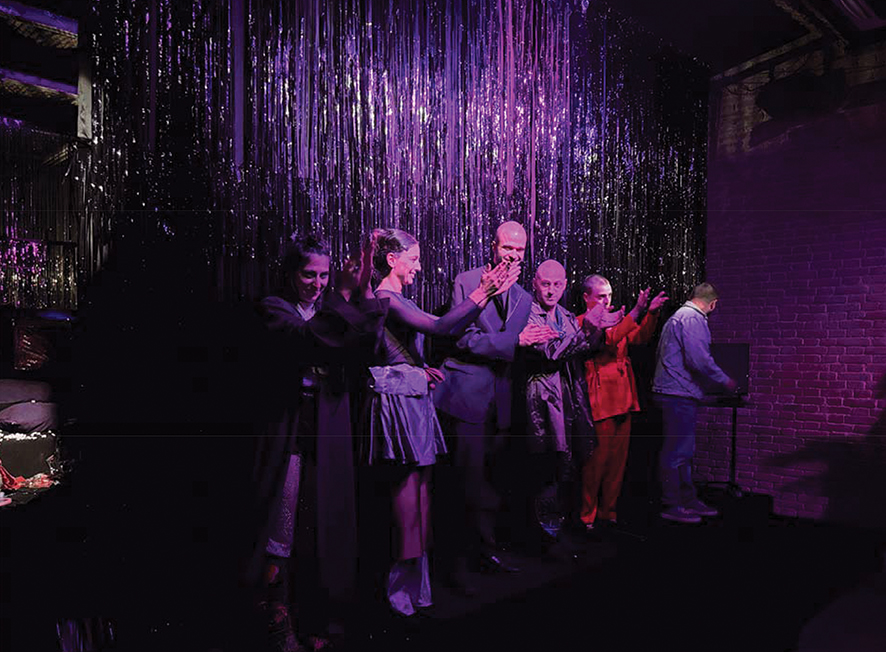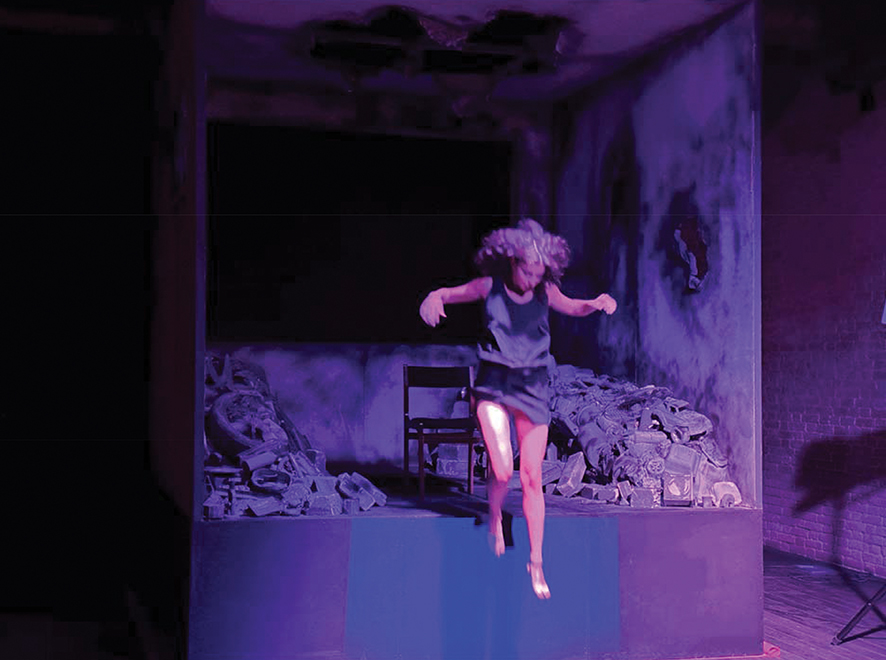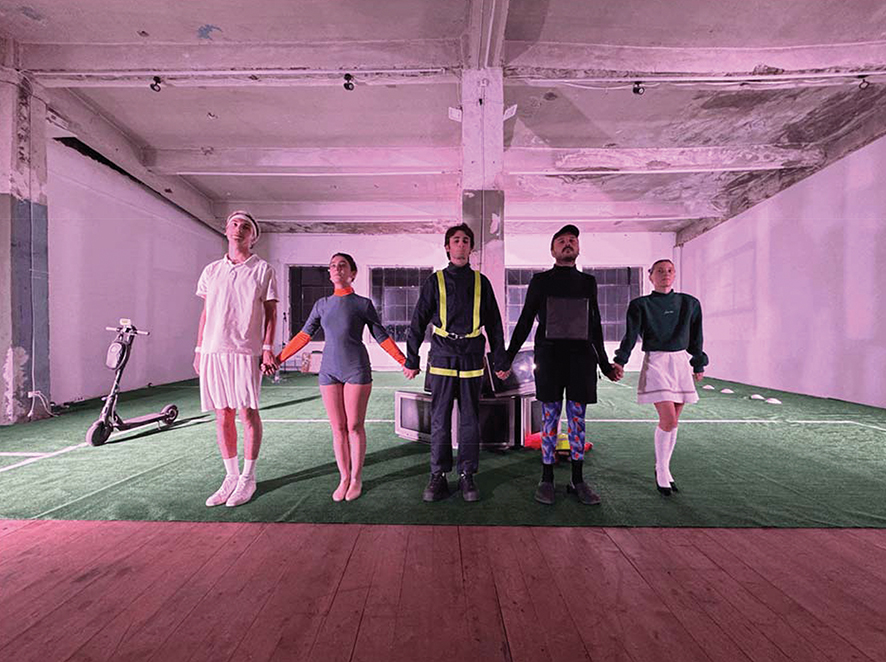The Georgian Showcase at the Tbilisi International Festival of Theater 2024 presented a vivid portrait of the emerging trends and the fresh perspectives of theater in Georgia. Among the highlights of the showcase were three innovative performances: Berserkers: At Home, directed by Giorgi Jamburia; HA, a one-woman show directed by Sandro Kalandadze; and Fire, a student production from the Open Space (Center for Performing & Visual Arts). Each of these performances, though distinct in its style, technique, and narrative structure, sheds light on the current direction of youth theater in Georgia, emphasizing experimentation, social relevance, and personal introspection.

Berserkers: At Home – The Revolt Against Theatrical Convention
Giorgi Jamburia’s Berserkers: At Home stands out as a quintessential example of how young Georgian directors are breaking away from traditional forms to create an immersive and unpredictable theatrical experience. Drawing from themes of existentialism, failed utopias, and human isolation, the performance operates as an experimental social drama that transcends mere storytelling. Jamburia not only writes and directs the play, but also designs the scenography, making it an intensely personal creation that reflects his broad vision of theater.
The performance’s interactive nature, where the audience’s reactions play a significant role in shaping the progression of the action, breaks the conventional divide between stage and spectators. This approach evokes a sense of intimacy, creating a new form of artistic reality, where the performers and viewers exist in a shared emotional and physical space. Jamburia’s manipulation of tempo and rhythm, driven by improvisation, constructs a unique narrative flow that contrasts with the rigid structures typical of more traditional plays. Berserkers: At Home exemplifies a vital trend in youth theater—an embrace of unpredictability, fluidity, and direct engagement with the audience. By doing so, Jamburia fosters a kind of resistance to conventionality, a theme that runs parallel to the disillusionment with larger societal ideals, such as the critique of failed political utopias presented in the text.
This performance not only questions ideological principles, but also challenges the core of theatrical presentation, urging the audience to rethink their relationship with art, space, and each other.

HA – The Power of the Human Voice as an Instrument of Memory
Sandro Kalandadze’s HA, a one-woman show featuring Anano Makharadze, strips down theater to its bare essentials, relying on voice, breath, and sound to convey a profound emotional narrative. The monologue, written by Mariam Megvinyte, explores the experiences of those who have perished unjustly in war, and the performance transforms their silence into a resonating cry.
HA represents a significant departure from more visually driven performances. Kalandadze’s use of sound and breath as central elements in the play’s structure points to a growing experimental trend in Georgian youth theater—an exploration of non-verbal communication and the physicality of performance. By focusing on the nuances of breath and voice modulation, the play forgoes traditional dialogue for a more primal expression of pain, suffering, and remembrance. The performer’s breath becomes a conduit for the stories of the dead, bridging the past and present in a deeply symbolic way.
The minimalist staging and the focus on the human voice place HA within the broader global trend of deconstructing theater to its core elements. However, the performance’s context in Georgia gives it a particular resonance, as the country continues to grapple with its own violent history. In this way, HA becomes more than a theatrical experiment; it is an act of collective memory and a poignant reminder of the ongoing impact of war on both the living and the dead.

Fire – Navigating through Personal and Global Crises
The student-led collaborative performance of Elene Burchuladze, Masho Makashvili, Elene Mindiashvili, Nika Shanava, Luka Chibukhaia and Luka Japaridze Fire curated by Davit Khorbaladze and Mikheil Charkviani is perhaps the most overtly political and socially conscious of the three productions, drawing parallels between the personal emotional turmoil of its participants and the environmental catastrophe that serves as the performance’s central metaphor. The performance delves into themes of identity, sexuality, depression, and the uncertainty of the future, all framed within the context of a world that is literally and figuratively “on fire.”
The use of personal stories as the foundation of the performance positions Fire as a documentary-style piece, where the real experiences of the performers are transformed into theatrical art. This is a trend increasingly seen in youth theater worldwide, where lived experiences become the primary material for performance, allowing for a raw and authentic exploration of societal issues. In Fire, the pervasive anxiety over the environment mirrors the inner emotional landscapes of the performers, creating a powerful symmetry between the global crisis and individual struggles.
The production’s use of multimedia highlights the influence of digital culture on the younger generation. By incorporating loops of screenings and authentic landscape outside the window, the performance captures the dissonance between virtual escapism and the harsh realities of the world outside. The continuous refrain of “Wake up!” in the performance acts as a call to action, not only for the characters but also for the audience, urging them to confront both personal and societal crises.

A New Wave of Expression
The three performances from the Georgian Showcase of the Tbilisi International Festival of Theater 2024—Berserkers: At Home, HA, and Fire—represent a powerful tapestry of modern Georgian youth theater, reflecting the themes, trends, and aesthetic tendencies of a new generation of artists. These works highlight experimental social drama, intimate and personal storytelling, and the merging of individual and collective experiences.
Existential Crisis and Social Commentary: Across all three performances, we see a deep engagement with existential questions and a reflection on contemporary social issues. Berserkers: At Home uses a cyclical narrative about utopian ideals, love, and nihilism, exploring the disillusionment with grand societal narratives like communism and the trivialization of emotions such as love. This work grapples with the search for meaning in a world where traditional values seem exhausted or irrelevant, revealing a sense of absurdity that mirrors the uncertainty of postmodern life. Similarly, HA tackles the devastation of war, trauma, and the weight of historical memory. By giving a voice to the dead, this performance suggests that the unresolved past haunts the present, and the chaos of modern life is inescapable. This emotional weight is further reflected in Fire, where personal stories of identity, love, depression, and sexuality are intertwined with environmental catastrophe. The performance’s use of fire as a metaphor for the chaos and uncertainty that dominates both personal and global spheres encapsulates a generation’s anxiety about the future.
Fragmented Narratives and Personal Stories: All three performances emphasize fragmented, episodic structures, breaking away from traditional linear storytelling. In Berserkers: At Home, the characters’ interactions feel disjointed, with shifts in tone and subject matter, echoing the breakdown of coherent worldviews. HA is similarly fragmented, with the lone voice oscillating between past and present, life and death. This technique reflects the fragmentation of contemporary consciousness, where personal and collective histories merge in disorienting ways.
Fire amplifies this by blending documentary storytelling with personal confession. The participants’ narratives are pieces of a larger emotional landscape, connected to a global environmental crisis. These fragmented narratives reflect the modern condition, where individuals struggle to form cohesive identities or make sense of an unstable world. This emphasis on personal stories, especially in Fire, suggests that youth theater in Georgia is deeply invested in exploring subjective experiences, particularly those often marginalized in society, such as mental health and sexual identity.
Critique of Utopian Ideals and Identity Politics: There is a critical stance toward traditional ideals and societal structures in all three works. In Berserkers: At Home, the character’s reflections on communism and the notion of love highlight a skepticism toward utopian promises. This echoes a broader cultural sentiment of disillusionment with ideologies that once offered hope but now seem irrelevant or oppressive. Meanwhile, Fire addresses the search for identity in an era of profound instability, where even the idea of a stable, coherent self seems elusive. This critique extends to HA, where the voice of the dead serves as a reminder that past traumas continue to shape present realities. The refusal to let go of historical pain reflects a society grappling with unresolved conflicts, both personal and political. The focus on identity politics, particularly in Fire, where sexuality and mental health are key themes, suggests that youth theater in Georgia is attuned to the complexities of selfhood in a rapidly changing world.
Experimental Forms and Improvisation: Each performance demonstrates a commitment to experimentation in form and technique. Berserkers: At Home relies heavily on improvisation and interaction with the audience, creating a dynamic and unpredictable performance that changes with each iteration. The physical and emotional state of the performers and the energy of the audience influence the direction of the performance, breaking down the traditional divide between performer and spectator. This improvisational approach allows for spontaneity and risk, hallmarks of contemporary experimental theater. HA uses sound and breath as its primary expressive tools, pushing the boundaries of traditional monologue. The performance’s emphasis on vocal modulation and breath control creates a unique auditory experience, transforming the performer’s voice into a physical presence that haunts the space. This approach highlights the potential for sound to convey emotion and narrative, even in the absence of conventional dialogue or plot.
Minimalist Scenography and Symbolism: The scenography in these performances is often minimalist, focusing on symbolic gestures rather than elaborate sets or props. In Berserkers: At Home, the proximity of the action to the audience creates an immersive, intimate experience, with the staging itself becoming a tool for breaking down conventional theatrical boundaries. HA similarly employs minimal visual elements, with the focus on the performer’s voice and body as the central means of expression. This stripped-down aesthetic forces the audience to focus on the performers and the emotional intensity of the performance. Fire uses fire as a central metaphor, suggesting both destruction and renewal. The minimalist staging of this performance allows the themes of environmental catastrophe and personal crisis to take center stage, with the performers’ physical presence and the symbolic use of fire creating a visceral connection between the audience and the performers’ inner worlds. The reliance on minimalist, symbolic scenography across these performances suggests a trend toward focusing on the emotional and conceptual core of the work, rather than on external spectacle.
Interdisciplinary Approaches: The use of interdisciplinary techniques, such as sound design, movement, and multimedia elements, is a key trend in these works. Fire, for example, incorporates the rhythms of media culture into the narrative structure, blending the personal and the digital in a way that feels distinctly contemporary. This integration of media culture into live performance suggests a growing awareness of how technology shapes identity and experience, particularly for younger generations.
The Future of Georgian Theater
Based on these performances, the future of Georgian theater appears to be one of innovation, experimentation, and social relevance. Young directors and theater-makers are pushing the boundaries of form, blending different disciplines and embracing non-linear, fragmented storytelling. There is a clear focus on personal and social issues, with themes like mental health, identity, and environmental crisis at the forefront. These performances reflect a generation grappling with a rapidly changing world, seeking new ways to express the complexities of modern life.
The aesthetic choices made by these young theater-makers—improvisation, minimalism, and interdisciplinary approaches—suggest a move away from traditional theatrical forms in favor of more fluid, experimental methods. This willingness to break with convention, coupled with a deep engagement with contemporary social issues, points to a future in which Georgian theater will continue to evolve as a platform for personal and collective expression.
In summary, the theater of Georgia, as seen in these three performances, is characterized by a bold experimentation with form, a deep engagement with existential and social questions, and an aesthetic minimalism that foregrounds the emotional and conceptual power of performance. This new wave of theater-makers is not afraid to confront difficult themes, and their work suggests a vibrant future for Georgian theater—one that is deeply connected to the realities of contemporary life and committed to exploring new artistic possibilities.
By Ivan Nechaev














